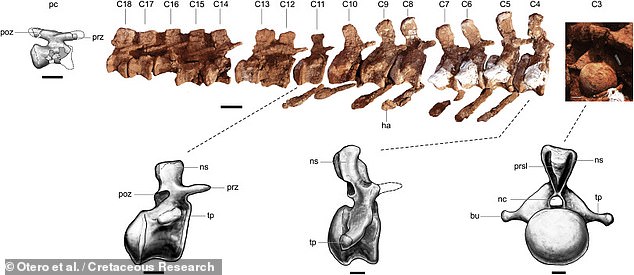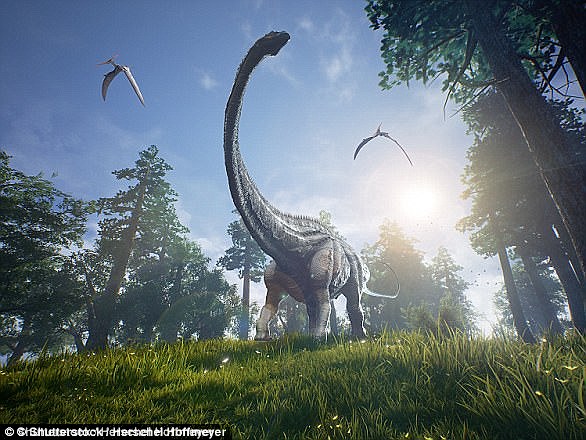
Fossils: A 98-million-year-old dinosaur discovered in Argentina may have been the largest land animal ever
The study revealed that a 98-million-year-old dinosaur fossil discovered in Argentina may have been the largest walking animal on Earth.
- Fossil remains – including the tail and pelvic bones – were discovered in 2012
- The giant dinosaur Titanosaur sauropod had a long neck and long tail
- It was preserved in a muddy flood plain in what is today Neuquen County
- Researchers believe that the remains could belong to a new species of sauropods
- They think it was larger than Patagotitan, which grew to about 121 feet
The fossilized bone of a dinosaur discovered in Argentina that would have trampled the Earth 98 million years ago may have been the largest land animal ever.
Local paleontologists found the remains – which include 24 vertebrae of the creature’s tail and some adjacent pelvic bones – in Neuquen County in 2012.
Thought to be a titanosaur, one of the largest sauropods – a class of dinosaur that is distinguished by its large size, column-like legs, neck, and elongated tail.
While the team has not been able to confirm this as a new species yet, the fossils do not appear to match the remains of other known sauropod dinosaurs.
The discovery may help experts to better understand how giant Serbian dinosaurs evolved and lived millions of years ago.
Despite the new discovery, the blue whale still maintains the title of “largest animal ever” – which was known to be 110 feet (33.6 meters) long.

It could be the fossilized bone (pictured) of a dinosaur discovered in Argentina that would have trampled the Earth 98 million years ago, it might have been the largest land animal ever.
![`` It is clear that a titanosaur that has been partially recovered from the formation of Candelarus can be considered one of the largest of the titans, '' the researchers wrote. Possibly of a body mass similar to Patagotitan [pictured, in a full sized model] Argentinosaurus or greater](https://c2wlabnews.nl/wp-content/uploads/2021/01/1611007153_752_Fossils-A-98-million-year-old-dinosaur-discovered-in-Argentina-may-have-been.jpg)
“ It is clear that a tetanosaur that has been partially recovered from the Candeleros formation can be considered one of the largest of the titans, ” the researchers wrote. Possibly of a body mass similar to Patagotitan [pictured, in a full sized model] Or Argentinosaurus or greater
The fossil remains are found in strata of rocks that geologists refer to as the “Candeleros Formation” – more specifically at a level that represents sediments from the muddy flood plain.
“ It is clear that a titanosaur that has been partially recovered from the formation of Candelarus can be considered one of the largest of the titans, ” the researchers wrote.
“It is possible that the body mass of the Patagotitanian or Argentine or greater,” they added.
Patagotitan – which was first discovered in Argentina in 2013 – is thought to have reached lengths in excess of 121 feet (37 meters) and likely weighed 55-57 tons.
Unlike other remains extracted from the formation, this specimen – identified as “MOZ-Pv 1221” – remained largely articulated, indicating that more of the skeleton was likely to be uncovered in the same place where the drill progressed.
In fact, the team reports that dinosaur limb bones have been found, but not yet excavated.
Due to the partial nature of the discovery thus far, the researchers said it was not yet possible to estimate how much MOZ-Pv 1221 would likely weigh in life.

Unlike other remains extracted from the formation, this specimen – identified as “MOZ-Pv 1221” – remained largely articulated, indicating that more of the skeleton was likely to be uncovered in the same place where the drill progressed. Pictured, an artist’s impression of MOZ-Pv 1221 and – below it – two other sauropods from the same location, Limaysaurus (left) and Andesaurus (right)

Due to the partial nature of the discovery thus far, the researchers said it was not yet possible to estimate how much MOZ-Pv 1221 would likely weigh in life. Pictured, an artist’s impression of the silhouette of the specimen, showing the still-exposed bones
According to the researchers, Neuquén County was home to several Sauropod species 98 million years ago – each having a different role, or “place,” in the ecosystem and food web.
The specimen reported here strongly indicates the presence of larger and medium-sized titanosaurs with smaller ribachiosaurs at the beginning of the Late Cretaceous. […] Referring to a supposed niche split, “they said.
The full results of the study have been published in the journal Cretaceous search.

